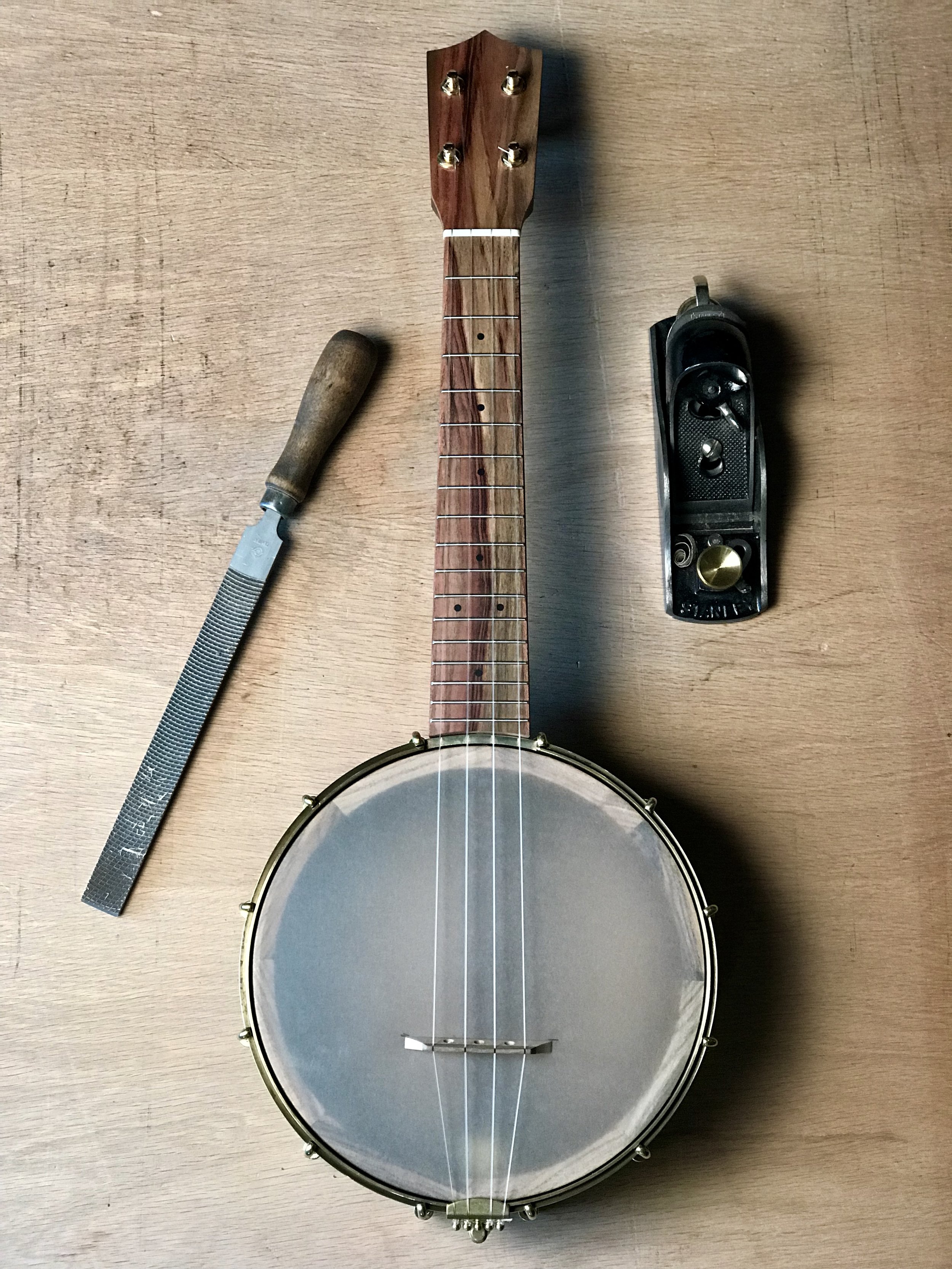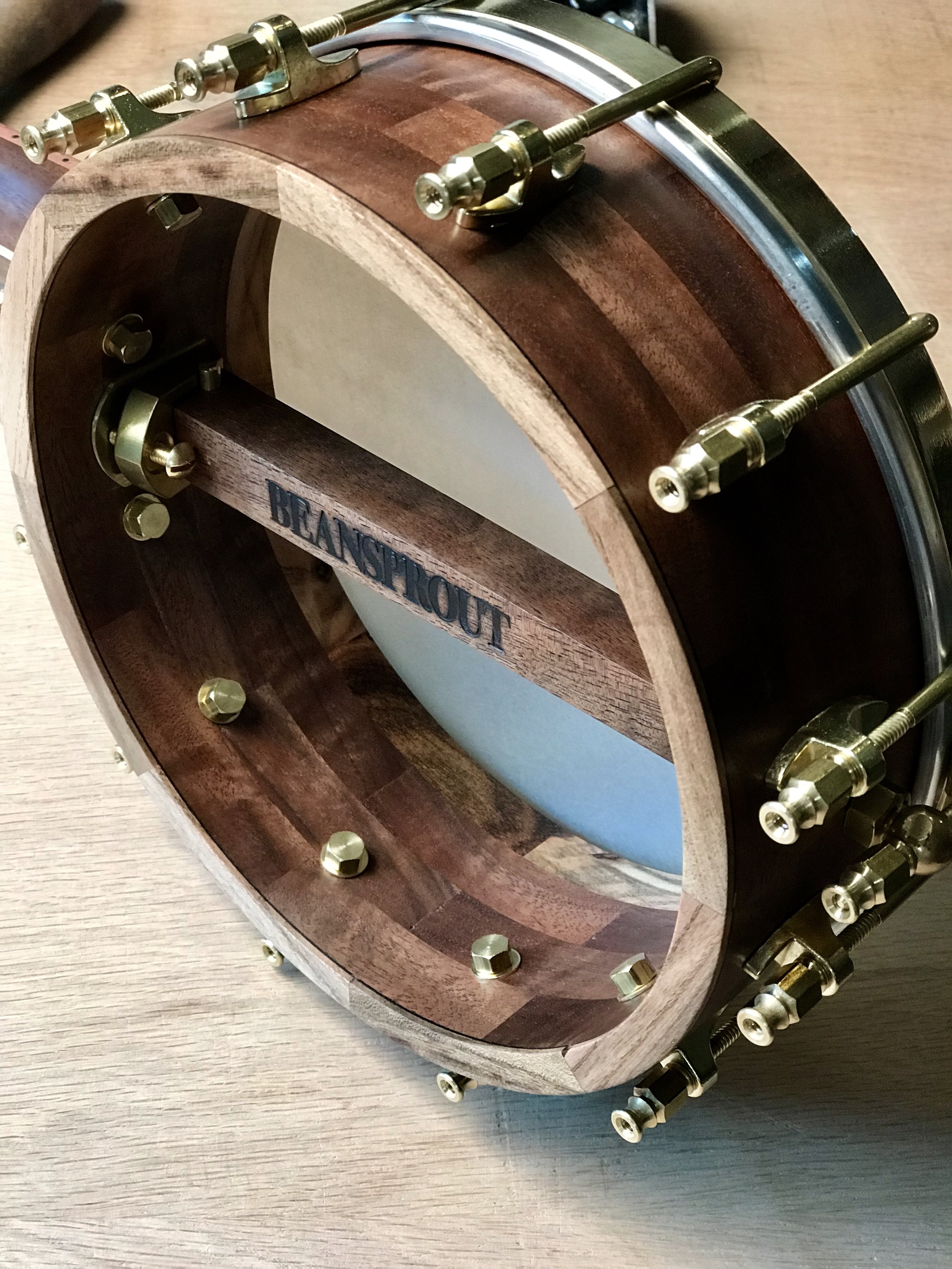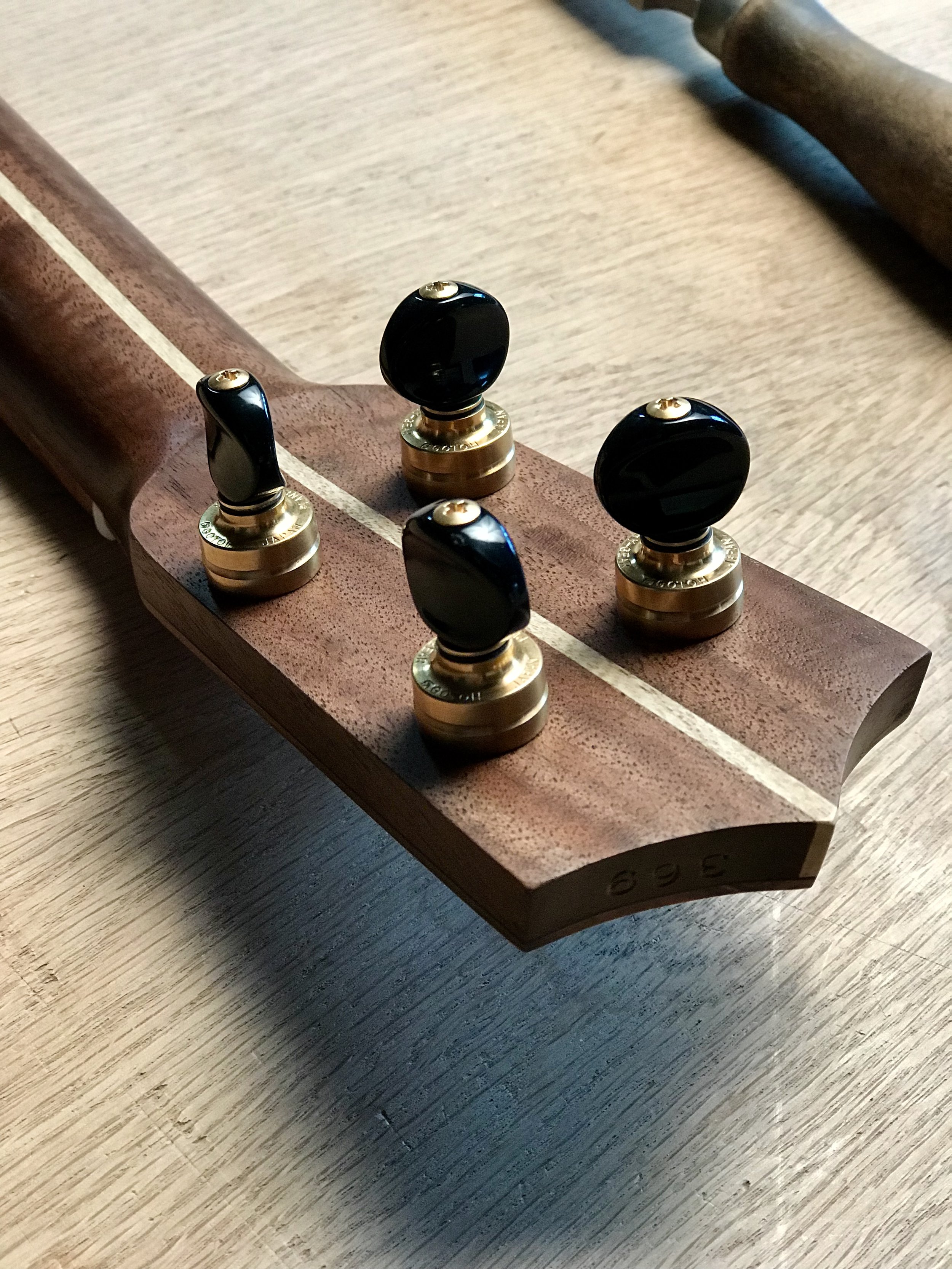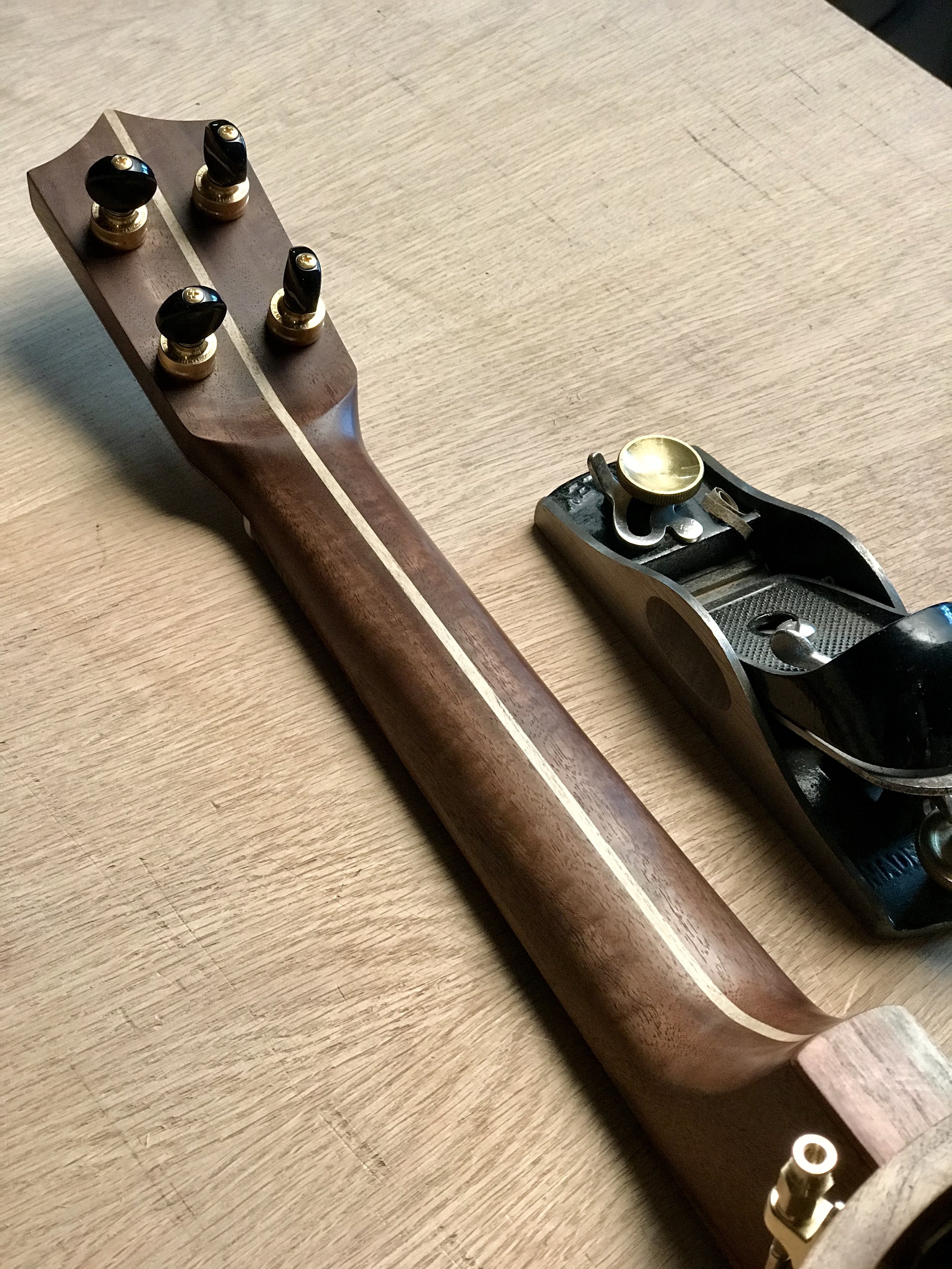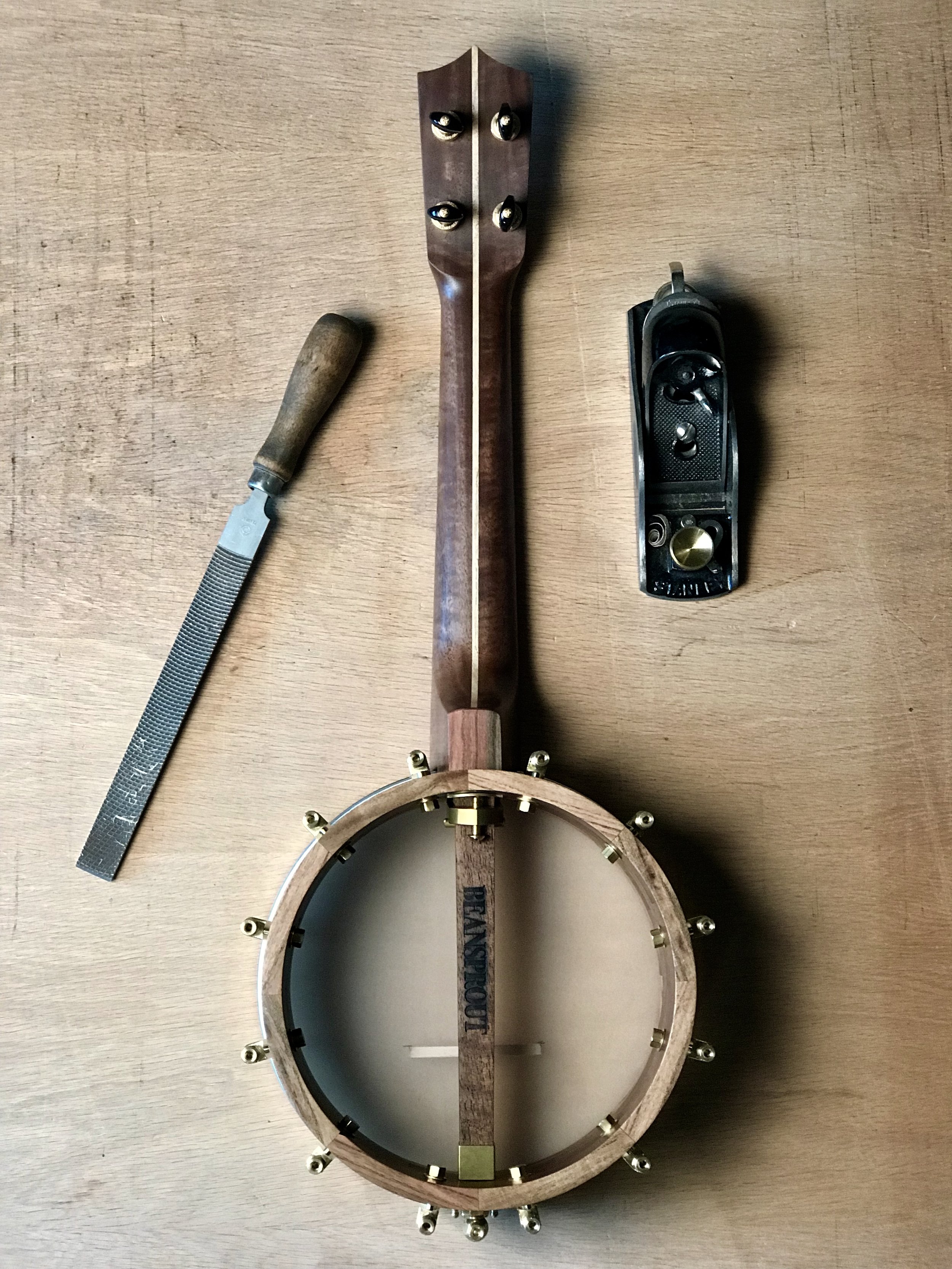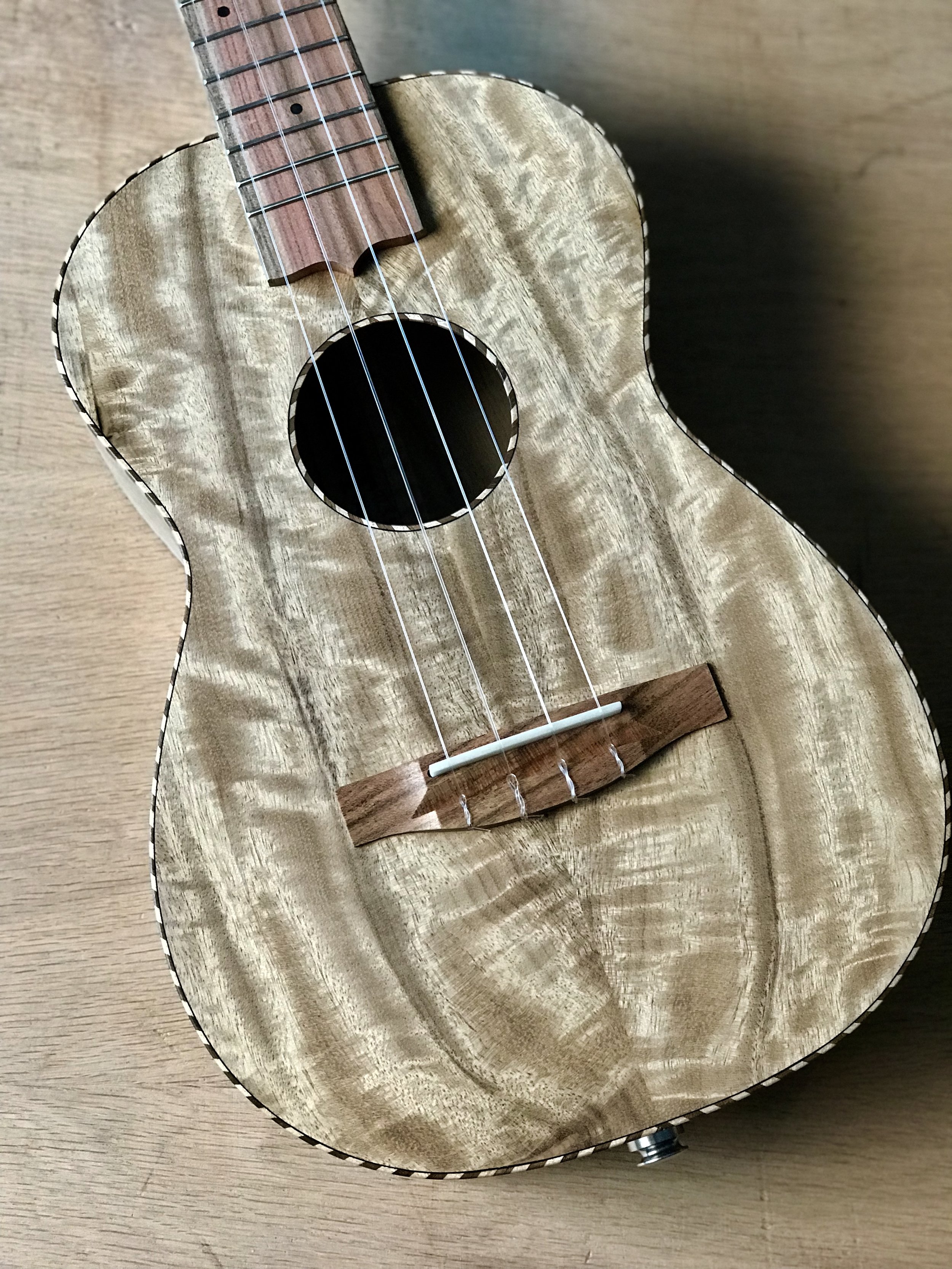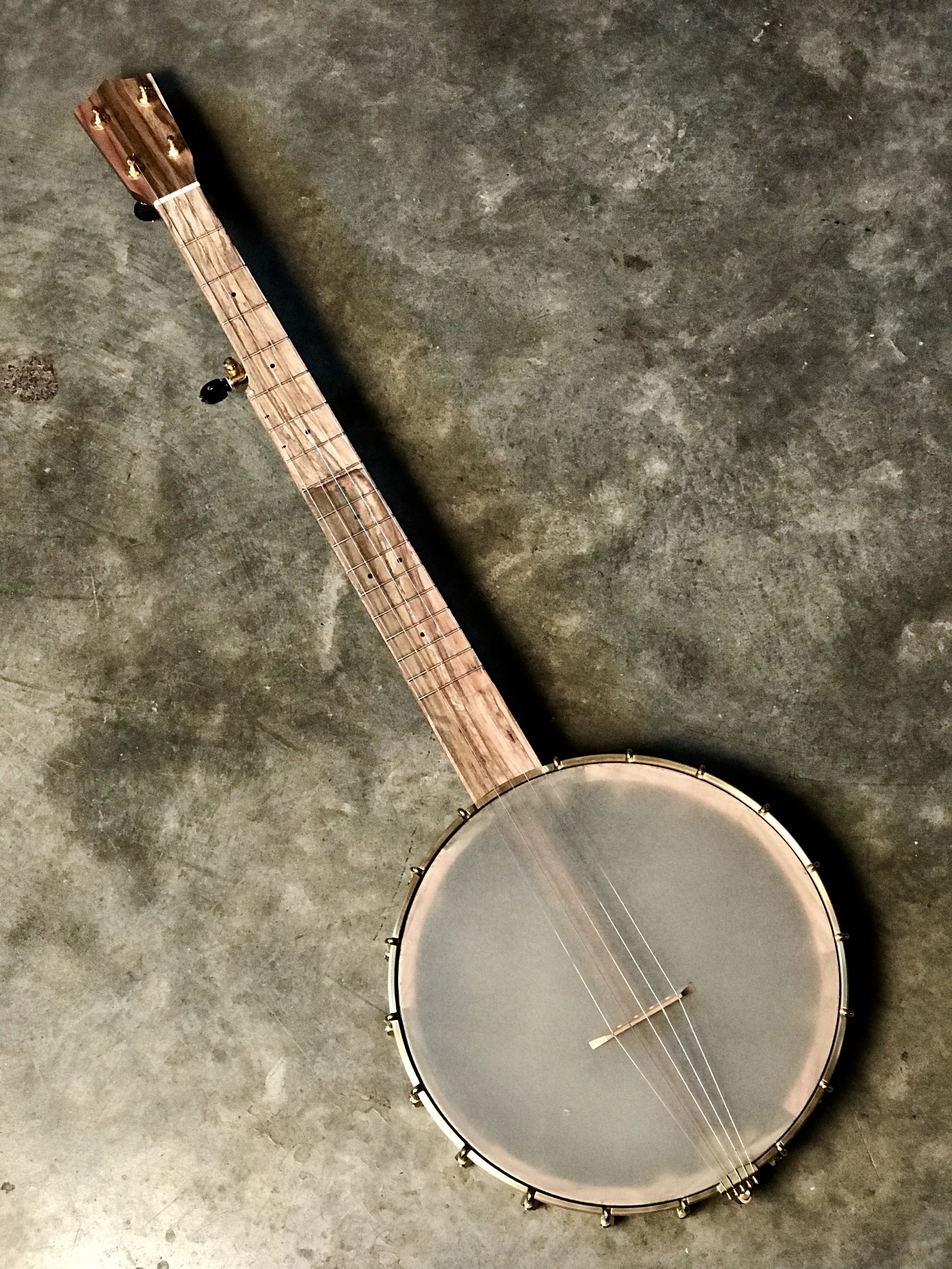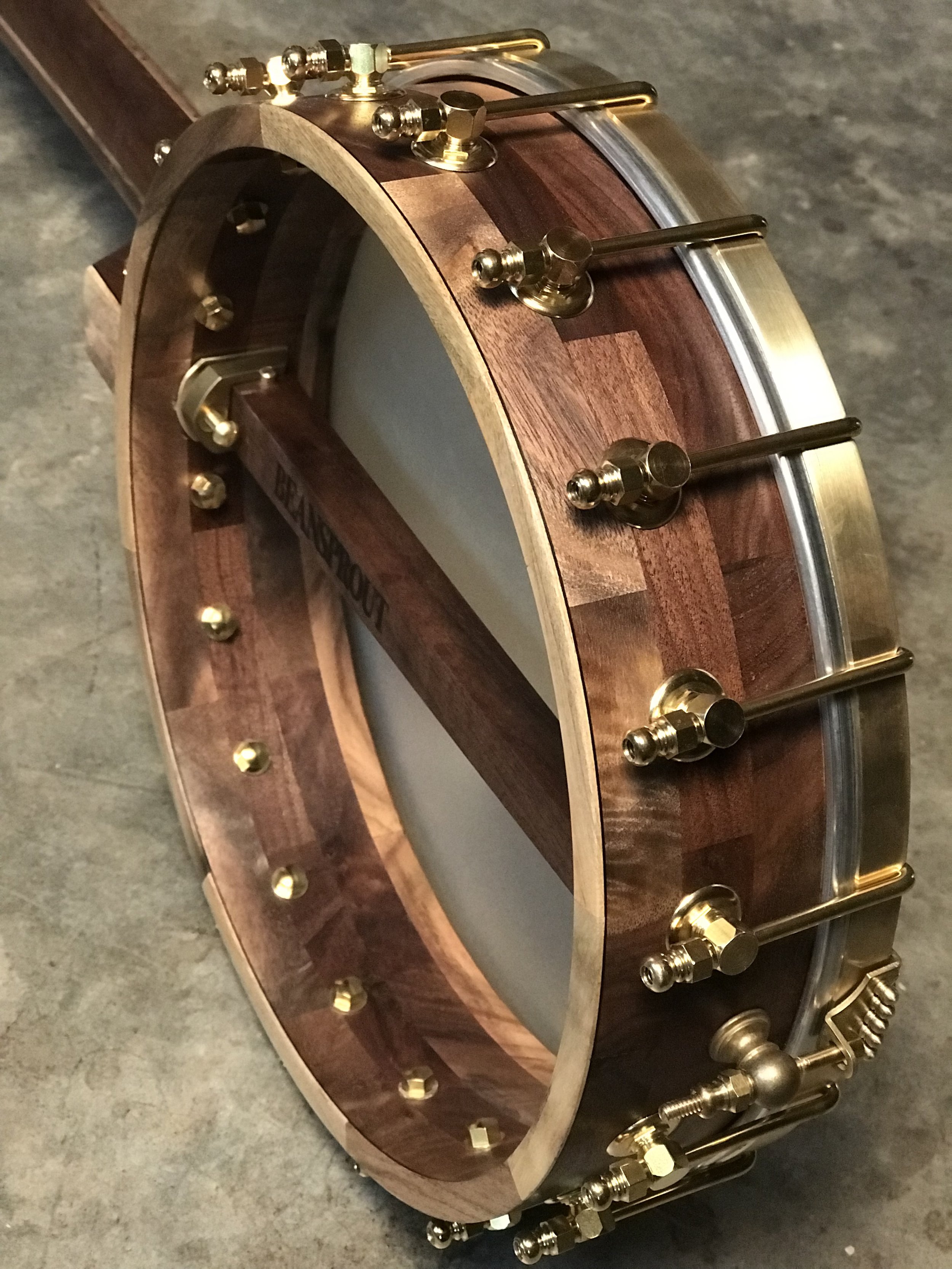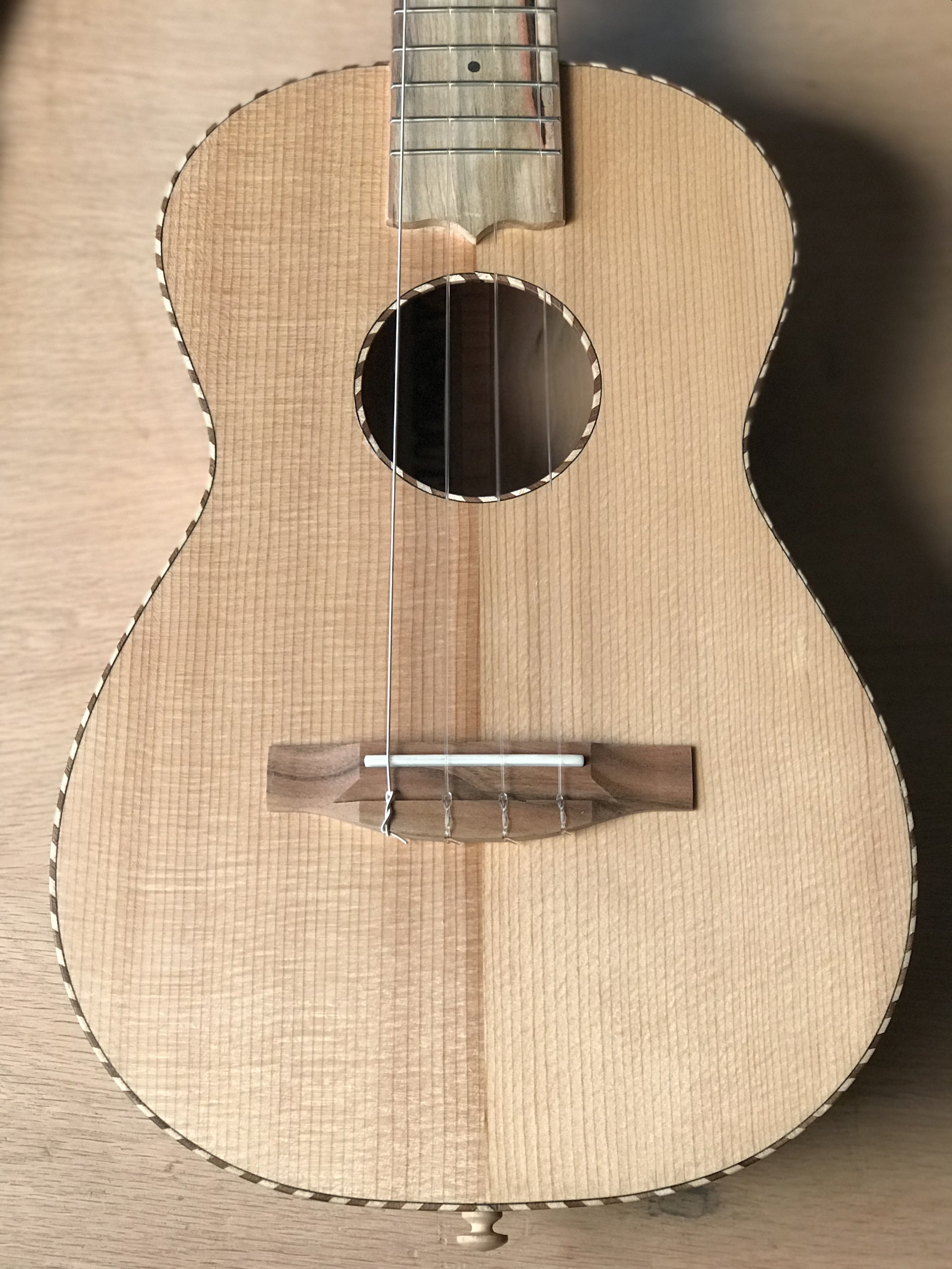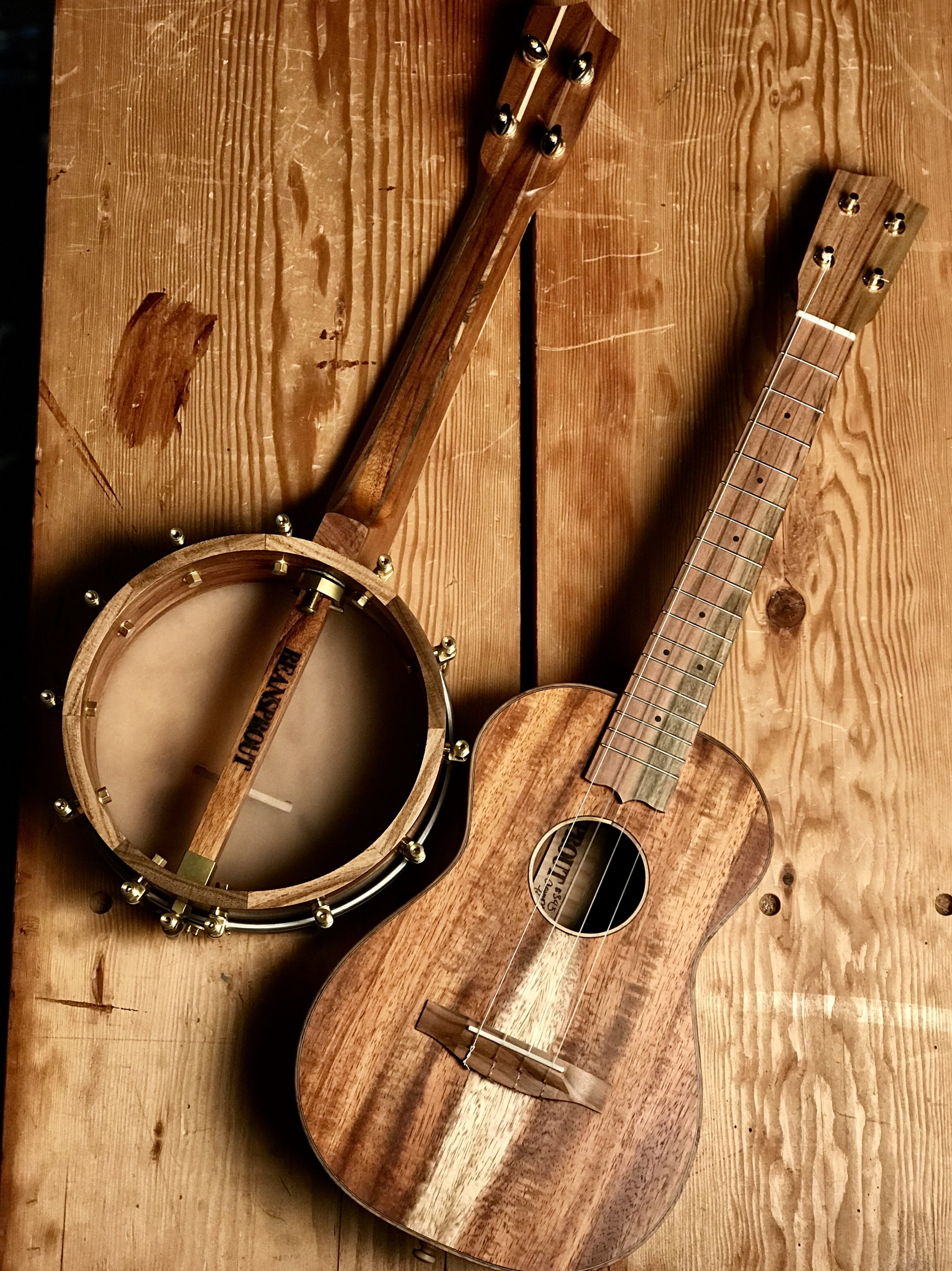Although there is precedent for using oak in banjos, especially banjos from the 19th Century, there aren’t many modern banjos being made with it. After making a few, I’m really not sure why. It looks nice, has a balanced sound, isn’t too heavy, is easy to work and is readily available. I’m going to stick with it. This Oregon white oak comes from Zena Forest Products out of Salem. It is a family owned operation that sustainably manages their forest and provides high quality lumber. The two tone pistachio is culled from California Orchards. Notice how I also used grafted pistachio on the fretboard binding to off set the graft line in the fingerboard. Fun fun.
#363 Curly Port Orford Cedar and Mastergrade Walnut Tenor Ukulele
This instrument is part of a set of three this month for a loyal customer. It was fun to set up a matched pair of tenor and baritone ukes and an additional Myrtle tenor for them. I like imagining these instruments as stand alone items as well as in conversation with their siblings. This particular instrument is a great example of my best looking and sounding woods, prepared to the highest level I am currently capable of. But, it is a piece of folk art before fine art, as it shows its hand made origins, is made with local materials on hand and celebrates tiny natural flaws and textures. The Port Orford cedar top, grafted walnut back/sides and grafted pistachio comes from Oregon and California via woodfromthewest.com. The salvaged Douglas Fir for the neck comes from a barn in The Dalles, OR from Portland Salvage Works. The tone, volume, sustain and playability are spot on. It’s nice to look at but even better to play!
#369- Curly Walnut and Pistachio Concert Banjo Uke
The walnut I get from Goby in Portland comes from the cutoffs that are too small for the furniture makers to use. They harvest dead and dying trees from all over the Willamette Valley and plant five for everyone they cut. I also pay to have a tree planted for every uke sold, also trying to close the sustainability gap. The pistachio for this one comes from culled orchard trees from central California, harvested by woodfromthewest.com. It may seem like these sourcing details are secondary to how the banjo looks, sounds and feels, but to me they are a primary factor. After all, these sourcing decisions help me to work closer to the original tree, support good suppliers and ensure that we are doing our best to be stewards of these beautiful North American resources.
#358- Curly Myrtle Tenor Ukulele
I love how each species of wood has its own character, but within a species there is also a great deal of diversity. Myrtle is a good example. It’s color can range from almost white to dark green/brown. I love this light colored curly stuff and I am really pleased with how it turned out. Wrapped in rope binding and paired with simple pistachio fretboard and a Fir floorboard neck.
“Hi, Aaron and Nicole,
I received my myrtle tenor ukulele yesterday, and I absolutely love it. It sounds great, feels great, and is even more beautiful than in the photos.
Thank you!
- T. C. ”
#357- Myrtle Alto Ukulele
Magda asked for an alto ukulele similar to another I made that referenced Wabi-Sabi as an aesthetic and cultural influence. I happily set aside a set of this asymmetrical Myrtle for her, happy to continue to explore the idea. Wabi-Sabi is a Japanese idea that celebrates natural imperfection, muted earth tones, authentic textures and asymmetrical designs. It is an interesting exercise to explore this while making sure that tone and playability are un-affected. The Myrtle for this uke came from Char at Mya-Moe before she retired. The pistachio is from California Orchards and the Fir is from salvaged floor boards.
#354- Fir and Pistachio Tenor Ukulele
Douglas Fir is an important wood for folks from the Pacific North West. It towers over our parks, builds our homes and is exported all over for Christmas trees. The modern, fast grown, plantation boards are wide grained and un-remarkable. The old growth has a suppressed grain, making it very strong for a soft wood and quite beautiful, in my opinion. I buy Fir salvaged from old buildings as often as I can. The Fir for this build comes from a barn in The Dalles, OR, purchased from Salvage Works in Portland. I just read on Wikipedia that Douglas Fir trees were also prized as material for Hawaiian canoes, as the logs washed up as drift wood. This bit of synchronicity gave me a chill, as I contemplate the meaning of my my career building ukuleles from this tree in Oregon. I am building from my prized local wood, just as the Hawaiians built from Koa. Yet, I prize the Koa I can manage to import from the islands, just as they prize these Fir logs. All of this is just a reminder of our local/global historical connections. This tenor uke is finished off with beautiful pistachio from California orchards and maple/walnut rope binding. A classic design I hope to keep making for folks.
#360 Walnut and Pistachio Tenor Banjo Ukulele
When it comes to what I do, “custom” isn’t quite the correct description. I offer a few models and options and take customer input and requests, but I really make the majority of decisions. This one had a few requests that I was happy to honor and I’m glad I did. It made for a great instrument that is a little different than normal but still fits inside my values. Specifically, the customer wanted a different brand of banjo head and a brass armrest. With the K&K pickup, it is certainly stage ready. The pistachio fretboard and headplate are first class with the grain matchup and I love the big knot in the Oregon walnut neck. Pistachio is from California orchards, the walnut is from the Carpenter Ant stash in Portland.
““Aaron –
The instrument arrived on Thursday, and is exactly what I wanted! I am so delighted with the look, feel and sound - it makes me smile every time I play!I especially love the shape and feel of the neck - I don’t believe I have ever held an instrument with such a smooth and amazing finish!”
- C.S.
”
#359- Walnut and Pistachio Concert Banjo Ukulele
It has been fun this past couple of years to experiment with the interaction of a basic form (a banjo uke) and the variable aesthetic qualities of the materials (walnut, pistachio, brass). Each one is a unique item that is also related by form to it’s brothers and sisters. It feels like a long term art project with each instrument another entry in the catalogue. In this case, the Oregon walnut is from the Carpenter Ant stash and includes some curl and some sap wood. The California pistachio looks plain from far away but shows beautiful detail up close. It is just like the others but is an individual as well, #359 is ready for service.
“All I can say is WOW! What a gorgeous instrument. It sounds exactly like what I’d hoped for. I have a 1920’s Gibson UB-1 that is definitely “all banjo,” very twangy and almost a little too strident. I had read somewhere that Gibson re-purposed mandolin necks for many of the banjo ukes and this must’ve been the case with this one. It is very difficult to play. I was hoping for a playable banjo uke that had “that” sound but not so over the top. #359 (need to come up with a better name) has it in spades! The attention to detail is amazing. The walnut, pistachio and brass just look so good together. I also want to put in a good word about the “case candy.” I love the natural paper and handwritten work. It fits the whole vibe. Thank you, thank you.”
#352- Mastergrade Myrtle Tenor Ukulele
Another example of how Mastergrade Myrtle is “our” koa. It is beautiful, local and sounds great. The grain and curl on this one is one of a kind, so I wrapped it up in rope binding and paired it with straight grain pistachio and a simple spruce neck. Destined for our friend Tony, I’m sure it will be quickly put to service leading songs and jams. The Myrtle and pistachio comes from woodfromthewest.com. The spruce is from Camp Westwind on the Oregon coast.
“Hi Aaron and Nicole,
My Beansprout ukulele #352 arrived last Friday in great shape. It is breathtakingly beautiful. The Myrtle, the Pistachio, the workmanship, the sound are as good as I ever hoped for. The Myrtle is so beautiful, that while I generally don’t name my music instruments, #352 is now officially “Myrtle.” Kind of a neat old-fashion name that means time honored beauty to me. I have played Myrtle at home, on breaks at work, and in a couple of Twin Cities Ukulele Club jams. Wonderful! While everything is great, a real highlight for me is the neck shape, width and depth. Sooooooo comfortable! Thank you for Myrtle!
This photo is from a weekly Wednesday morning jam with a bunch of bluegrass guys - guitars, mandolins, fiddles, banjos and Ubass. Myrtle truly more than held her own!
-T.A.”
#355- Myrtle Tenor Ukulele For Nicole
The last instrument I made for Nicole was for our 10th wedding anniversary. It was a Mya-Moe Myrtle tenor cutaway with custom inlay. It has been all over the world since then and Nicole’s main uke. She recently asked for her own Beansprout and picked out two sets of Myrtle. I started on her uke but made a mistake and had to scrap the top. She asked to start over with the other, plainer set and it was a good thing.
This uke, like Nicole, feels strong, wise, calm and focused. Her last uke was whimsical and fun, but this better suits her and our current business/marital relationship. She is the foundation on which all of my work rests and she deserves all the love and praise in the world. This one is for her.
The striped Myrtle and pistachio comes from woodfromthewest.com. The neck is made from salvaged fir floor boards.
#356 Walnut and Pistachio Five String Banjo
Making a thing is easy. Making it over and over again pushes you to not just tweak the design, but to tweak the process as well. In this case, I wanted to spend some time this winter working on the production design for my five string banjos. I had a few jigs to modify, some new templates to make, a new dedicated router setup and I needed some practice on the lathe. I was going to make a curly walnut banjo anyway, so when an order came in we all won out.
The lightly curly walnut for this one comes from urban salvage from Goby Walnut in Portland. The pistachio is from California orchards. It is lightweight but solid, sweet and rich with nice volume, suitable for many old time banjo jobs. The brass hardware comes from Brooks Masten in Portland.
For folks wondering about walnut vs maple in banjos, check out the second video below.
#347- Spruce and Cherry Tenor Ukulele
One of the best parts of making stock instruments to my own specs is that I get to choose woods that might be over looked by customers. These cherry back and sides are a great example of a figured hardwood that is readily available, looks beautiful and sounds great. Also, I could pick some “orphaned” slices of spruce for the top and a fretboard that needed a bit of extra work because of a natural bark inclusion. This one looks unique, sounds fantastic and fits within my ecological/economic values for wood use. Win. The spruce is old growth Sitka that my friend Steve got me from a dulcimer builder. The neck is Hemlock from a salvaged floor joist, the cherry back and sides are from Char from Mya-Moe and the pistachio is from California Orchards.
#348 Master Grade Myrtle Tenor Ukulele
This is a special board of myrtle that came from another customer. It came to me as partial trade for her instrument and I was happy to be able to get another instrument or two from it. She bought it for a furniture project that never happened, now it gets to be an ukulele! When the top is this interesting, picking the other parts can be pretty challenging. In this case, I played it safe and left everything else straight grain and stripey. The fir neck comes from my friend’s property on Vashon Island, complete with bug holes. The pistachio comes from California Orchards.
#346- Curly Port Orford Cedar, Figured Walnut, Fir and Pistachio Alto Ukulele
This one really illuminates what I want Beansprout to be/do:
-Woods: All North American wood, from people I trust or salvaged from local sources. The curly Port Orford Cedar, pistachio and figured walnut come from the Oregon and California, provided by woodfromthewest.com. The fir is salvaged from factory floorboards in The Dalles, OR. The walnut and maple rope binding is made by Gurian in Seattle.
-Design: The alto size and shape is my attempt to provide an all purpose small size uke. Cute and traditional like a soprano, but a little bigger for adults to play comfortably. This simple template interacts with some asymmetrical and sculptural wood choices to make a unique but classic look
-Sound and playability: Loud but rich, with the charm of a vintage small ukulele. Easy to play all the way up the neck. Easy to keep in tune with geared tuners and ready to plug in onstage.
-Art vs Craft- Handmade with rustic details and unique wood “flaws/inclusions” but with careful craftsmanship and attention to detail. A beautiful thing that is also a useful tool.
Sorry for the mini manifesto, back to the shop.
#353 Walnut and Pistachio Tenor Banjo Ukulele
I often wonder what our business would look like if we didn’t have the internet to supply us with customers. In this case, James is a local, so his experience might give a little insight. To begin with, this instrument was bartered for, which is hard to do long distance. Also, he came over to the shop and picked out wood, which can’t happen with every customer. Lastly, if it ever needs repair or adjustment, he can just drop by instead of having to ship it. But, if I only built banjo ukes for locals, I have a feeling I wouldn’t get to build as many!
This lightly curly walnut is urban salvage from Goby in Portland. The beautiful green/gray/brown pistachio is from California Orchards.
#349- Clockmaker's Koa Concert Banjo Uke
A banjo uke made from Koa? Why not. The koa is from the Carpenter Ant Stash, from a pile of boards that Lizann’s grandfather made clocks from. The pistachio is from California Orchards. It’s going to Stephen, who has a wonderful connection with the date this uke was finished!
#345 Clockmaker's Koa Tenor Ukulele
Sometimes, it is easy to get distracted by the many paths (and woods) we have before us. When that happens, I feel good about falling back on the tried and true, the classic designs. My four year old son Henry defines classic as “old but good” and I think he is right. In this case, a koa tenor ukulele with a mahogany neck. Super classic. I added the pistachio fretboard, headplate and trim to make it my own, but it falls squarely in line with the long tradition of Hawaiian craftsman that I sit at the feet of. Go play it, Doug, you are a true classic who deserves a classic uke.
The koa come from the Carpenter Ant stash, from the boards that Lizann’s grandfather made clocks from. The Pistachio is from California Orchards. The mahogany is salvaged from a fireplace mantle.
#343- Bear Claw Spruce and Master Grade Myrtle Tenor Ukulele
Lately I have been drawn to the muted tones and matching colors/textures of the Wabi-Sabi aesthetic, but for this design I was interested in exploring more visual contrasts. The old growth bear claw spruce top from Alaska Specialty Woods has a vibrant look and sound. The dynamic pistachio fretboard introduces red and green elements. The master grade myrtle back and sides from the Oregon coast (provided by woodfromthewest.com) brings a vibrant sound and whimsical texture that interacts with the green from the fretboard. The Douglas Fir neck is salvaged from floor boards and includes one nail hole to remind us of our flaws. A bit of this and a bit of that, but I love it just the same, wrapped up in rope binding.
Today we found out that poet Mary Oliver passed away, so I leave you with her words:
You do not have to be good.
You do not have to walk on your knees
for a hundred miles through the desert repenting.
You only have to let the soft animal of your body
love what it loves.
I love this uke and I love the people I made it for.
#350- Maple and Pistachio Tenor Banjo Ukulele
About 3 years ago, I went to a cabinet maker’s estate sale one town over. His shop was a one car garage and he had no dust collector! The entire place had 12” of wood shavings and scraps on the ground. In one corner, I found a pallet of maple strips cut to 1”x3”x24” and bought them all. I should have bought the oak pallet too! When I got them home, my son Henry had fun laying them out as a dance floor in the shop. He would put a bunch out while I worked and then we would put them away when we were done. Anything to keep a little one busy, right! Having these strips already milled lets me see the grain and figure easily and quickly process them into banjo parts. A real blessing. This tenor model with a low G is all Henry’s dance floor maple and pistachio from California orchards.
#351- Walnut and Pistachio Concert Banjo Ukulele
I’ve been working lately to try and unify the materials for these instruments a bit more. What I mean is, the rim, neck, fretboard, headplate, etc…all get processed at different times up to three months apart. That means I have to keep track of what is what for several months of instruments at a time. Not a big deal, but it takes time, space and lots of extra wood inventory to make sure everything matches well. In this month’s case, I also am trying to make the fretboards and headplates flow together in an organic way, which also takes extra work. I think its worth it, even if no one else notices it! Walnut from the Carpenter Ant stash, pistachio from California Orchards.














